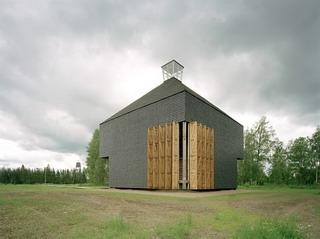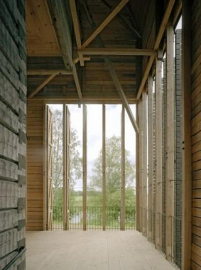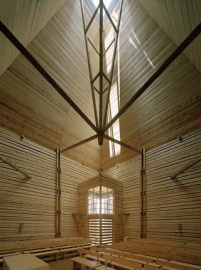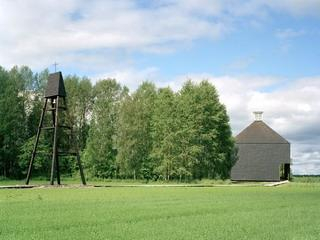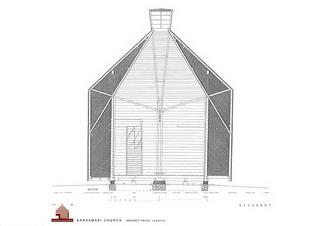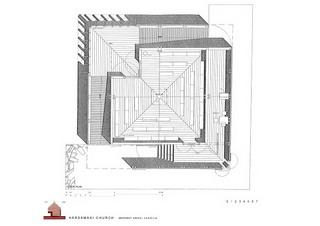Kärsämäki Church
Kärsämäki shingle church, located in the banks of the river, is a contemporary sacral space fully constructed with local, handicraft methods of the Finnish wood construction tradition.
The building waves a dialogue with the surrounding landscape through the use of local materials and the spatial composition.
The building of Kärsämäki Church answers the call of the local municipality, which in 1999 asked via open student competition to rebuild the original church of Kärsämäki parish, built in 1765, and later demolished in 1841. With no document witnessing the original appearance of the building, the brief of the competition - organized within the Department of Architecture at the University of Oulu- asked for building a new, modern church using traditional 18th century methods.
The task was to design a contemporary sacral space to be constructed with traditional handicraft methods. The aim was to achieve a sense of serenity and sacrality, an ecumenical atmosphere that would feel compelling and natural to all people. The design of the church is based on Anssi LassilaŽs winning entry Cantata.
The building is characterized by a strong sense of materiality evoked by the natural roughness of the handcrafted wooden elements. It consists of two basic parts: a log-built core and a black, tarred and shingle-clad cloak. With the chosen concept archaic simplicity and optimal weather resistance is endeavoured. The space between the cloak and the church houses the vestibules, vestry and a storeroom. When entering the church one is led through a dimly lit space towards the lighter colored main space lit by natural light from a lantern skylight. The natural light works in harmony with this interior space underscoring its character as a space for quiet contemplation. When dusk falls outside, the interior space is lit by movable, candle-lit glass lanterns and tinplate lanterns carried by churchgoers. There is no fixed seating in the church and the altar is movable.
An extensive research on traditional crafting methods was the base to choose the best materials and detailing solutions for the construction phase. Workers employed for the task were craftsmen or volunteers.
The logs for the loadbearing frame were felled from forests owned by the parish. A third of the log frame was erected on a field by the building site and when the foundations were completed, it was moved into place and the rest of the walls were assembled to their full height. The inner and outer surfaces of the log frame were hewn with a broad axe and the roof structures were constructed on-site mainly of 5 x 5 inch sawn timber.
The foundations are made with local stone and the foundation channels were hand shovelled in the ground. The ash logs were axe-split to create 50.000 shingles, later dipped in tar for optimal weather protection.
Being built with traditional techniques, the church achieves unique targets of sustainability and integration with the surrounding environment. Kärsämäki Shingle Church was crafted almost entirely by hand and materials are locally sourced.
An extensive research on traditional crafting methods was the base to choose the best materials and detailing solutions for the construction phase.
The materials are aging with time, adapting the shades and the textures to the landscape.
With no electricity, the building can be lit at night with candlelight while in daytime the interiors are discretely en


